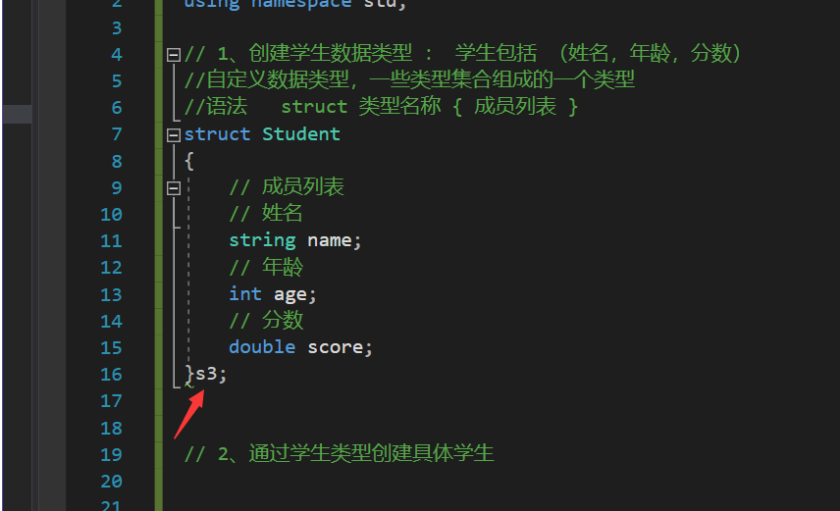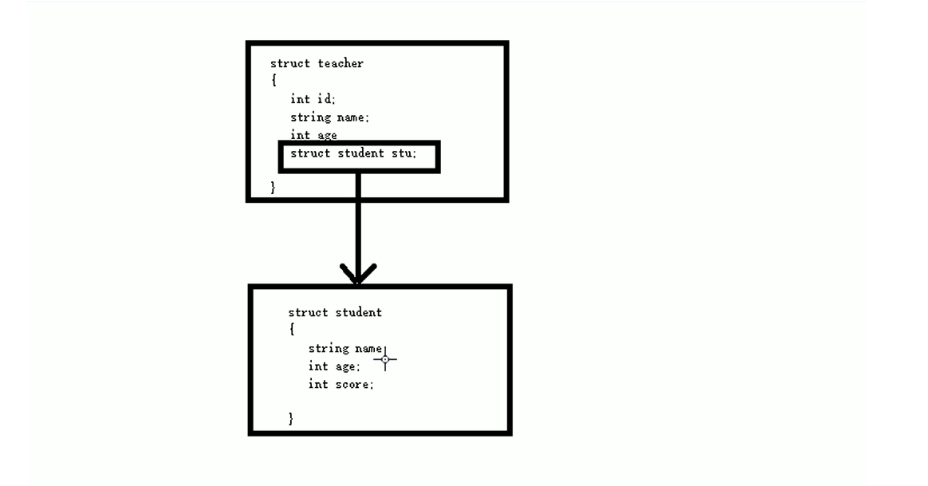C++结构体
结构体
结构体基本概念
结构体属于用户自定义的数据类型,允许用户存储不同的数据类型
结构体定义和使用
语法:struct 结构体名 { 结构体成员列表 };
通过结构体创建变量的方式有三种:
- struct 结构体名 变量名
- struct 结构体名 变量名 = { 成员1值,成员2值....};
- 定义结构体时顺便创建变量
示例:
#include <iostream> using namespace std; // 1、创建学生数据类型 : 学生包括 (姓名,年龄,分数) //自定义数据类型,一些类型集合组成的一个类型 //语法 struct 类型名称 { 成员列表 } struct Student { // 成员列表 // 姓名 string name; // 年龄 int age; // 分数 double score; }; // 2、通过学生类型创建具体学生 int main() { // 2.1 struct Student s1 // struct关键字可以省略 (创建的时候可以省略,定义的时候不可以省略)!!!! struct Student s1; // Student s1 (此处可以省略struct关键字) struct Student s1; // 给s1属性赋值,通过.访问结构体变量中的属性 s1.name = "张三"; s1.age = 18; s1.score = 85.5; cout << "姓名:" << s1.name << "年龄:" << s1.age << "分数:" << s1.score << endl; // 2.2 struct Student s2 = { ... } struct Student s2 = { "李四", 19, 90 }; cout << "姓名:" << s2.name << "年龄:" << s2.age << "分数:" << s2.score << endl; // 2.3 在定义结构体时顺便创建结构体变量 return 0; }
定义结构体时顺便创建变量(用的比较少)


总结1:定义结构体时的关键字是struct,不可省略
总结2:创建结构体变量时,关键字struct可以省略
总结3:结构体变量利用操作符"."访问成员
结构体数组
作用:将自定义的结构体放入到数组中方便维护
语法:struct 结构体名 数组名[元素个数] = { {}, {}, {}, ... {} }
示例:
#include <iostream> using namespace std; // 结构体数组 // 1、定义结构体 struct Student { string name; int age; int score; }; int main() { // 2、创建结构体数组 struct Student stuAaary[3] = { {"张三", 15, 88}, {"李四", 20, 90}, {"王二", 18, 100} }; // 3、给结构体数组中的元素赋值 stuAaary[2].name = "赵六"; stuAaary[2].age = 80; stuAaary[2].score = 60; // 4、遍历结构体数组 for (int i = 0; i < 3; i++) { cout << "姓名:" << stuAaary[i].name << "年龄:" << stuAaary[i].age << "分数:" << stuAaary[i].score << endl; } return 0; }
output:
姓名:张三年龄:15分数:88 姓名:李四年龄:20分数:90 姓名:赵六年龄:80分数:60 请按任意键继续. . .
结构体指针
作用:通过指针访问结构体中的成员
- 利用操作符
->可以通过结构体指针访问结构体属性
示例:
#include <iostream> using namespace std; // 结构体指针 // 定义结构体 struct Student { string name; int age; int score; }; int main() { // 1、创建学生结构体变量 struct Student s1 = { "张三", 18, 90 }; // 2、通过指针指向结构体变量 struct Student* p = &s1; // 3、通过指针访问结构体变量中的数据 cout << "姓名: " << p->name << "年龄: " << p->age << "分数: " << p->score << endl; return 0; }
output:
姓名: 张三年龄: 18分数: 90 请按任意键继续. . .
结构体嵌套结构体
作用:结构体中的成员可以是另一个结构体
例如:每个老师辅导一个学院,一个老师的结构体中,记录一个学生的结构体

示例:
#include <iostream> using namespace std; // 结构体指针 // 定义结构体 struct Student { string name; int age; int score; }; int main() { // 1、创建学生结构体变量 struct Student s1 = { "张三", 18, 90 }; // 2、通过指针指向结构体变量 struct Student* p = &s1; // 3、通过指针访问结构体变量中的数据 cout << "姓名: " << p->name << "年龄: " << p->age << "分数: " << p->score << endl; return 0; }
总结:在结构体中可以定义另一个结构体作为成员,用来解决实际问题
结构体做函数参数
作用:将结构体作为参数向函数中传递
传递方式有两种:
- 值传递
- 地址传递
示例:
#include <iostream> using namespace std; // 定义学生结构体 struct Student { string name; int age; int score; }; // 打印学生信息函数 // 1、值传递 void printStudent01(struct Student s) { cout << "在子函数1中打印 姓名:" << s.name << "年龄:" << s.age << "分数:" << s.score << endl; }; // 2、地址传递 void printStudent02(struct Student * p) { cout << "在子函数2中打印 姓名:" << p->name << "年龄:" << p->age << "分数:" << p->score << endl; }; int main() { // 将结构体做函数参数 // 将学生传入到一个参数中,打印学生身上的所有信息 // 创建结构体变量 struct Student s; s.name = "张三"; s.age = 18; s.score = 85; printStudent01(s); printStudent02(&s); // cout << "在main函数中打印 姓名:" << s.name << "年龄:" << s.age << "分数:" << s.score << endl; return 0; }
总结:如果不想修改主函数中的数据,用值传递,反之用地址传递
结构体中const使用场景
作用:用const来防止误操作
示例:
#include <iostream> using namespace std; // 定义学生结构体 struct Student { string name; int age; int score; }; // 将函数中的形参改为指针,可以减少内存空间,而且不会复制新的副本出来 // void printStudents(struct Student s) void printStudents(const struct Student *s) // 加入const防止函数体中的误操作 { // cout << "姓名:" << s.name << "年龄:" << s.age << "分数:" << s.score << endl; // s->age = 150; // 加入const之后,一旦有修改的操作就会报错,可以防止我们的误操作 cout << "姓名:" << s->name << "年龄:" << s->age << "分数:" << s->score << endl; }; int main() { // 创建结构体变量 struct Student s = {"张三" , 18 , 70}; // 通过函数打印结构体变量信息 // printStudents(s); printStudents(&s); return 0; }
结构体案例

示例:
#include <iostream> using namespace std; // 定义学生结构体 struct Student { string sName; int score; }; // 定义老师结构体 struct Teacherss { string tName; struct Student sArray[5]; }; // 给老师和学生赋值的函数 void allocateSpace(struct Teacherss tArray[], int len) { string nameSeed = "ABCDE"; // 给老师赋值 for (int i = 0; i < len; i++) { tArray[i].tName = "Teacher_"; tArray[i].tName += nameSeed[i]; // 通过循环给每名老师所带的学生赋值 for (int j = 0; j < 5; j++) { tArray[i].sArray[j].sName = "student_"; tArray[i].sArray[j].sName += nameSeed[j]; tArray[i].sArray[j].score = 60; } } }; // 打印所有信息 void printInfo(struct Teacherss tArray[], int len) { for (int i = 0; i < len; i++) { cout << "\t老师姓名:" << tArray[i].tName << endl; for (size_t j = 0; j < 5; j++) { cout << "学生姓名:" << tArray[i].sArray[j].sName << "考试分数:" << tArray[i].sArray[j].score << endl; } } }; int main() { // 1、 创建3名老师的数组 struct Teacherss tArray[3]; // 2、通过函数给3名老师的信息赋值,并给老师带的学生信息赋值 int len = sizeof(tArray) / sizeof(tArray[0]); allocateSpace(tArray, len); // 3、打印所有老师及所带的学生信息 printInfo(tArray, len); return 0; }
output:
老师姓名:Teacher_A 学生姓名:student_A考试分数:60 学生姓名:student_B考试分数:60 学生姓名:student_C考试分数:60 学生姓名:student_D考试分数:60 学生姓名:student_E考试分数:60 老师姓名:Teacher_B 学生姓名:student_A考试分数:60 学生姓名:student_B考试分数:60 学生姓名:student_C考试分数:60 学生姓名:student_D考试分数:60 学生姓名:student_E考试分数:60 老师姓名:Teacher_C 学生姓名:student_A考试分数:60 学生姓名:student_B考试分数:60 学生姓名:student_C考试分数:60 学生姓名:student_D考试分数:60 学生姓名:student_E考试分数:60 请按任意键继续. . .
修改分数随机数 (36行和61行int random = rand() % 61 + 40; // 40 ~ 100 )
#include <iostream> using namespace std; // 定义学生结构体 struct Student { string sName; int score; }; // 定义老师结构体 struct Teacherss { string tName; struct Student sArray[5]; }; // 给老师和学生赋值的函数 void allocateSpace(struct Teacherss tArray[], int len) { string nameSeed = "ABCDE"; // 给老师赋值 for (int i = 0; i < len; i++) { tArray[i].tName = "Teacher_"; tArray[i].tName += nameSeed[i]; // 通过循环给每名老师所带的学生赋值 for (int j = 0; j < 5; j++) { tArray[i].sArray[j].sName = "student_"; tArray[i].sArray[j].sName += nameSeed[j]; int random = rand() % 61 + 40; // 40 ~ 100 tArray[i].sArray[j].score = random; } } }; // 打印所有信息 void printInfo(struct Teacherss tArray[], int len) { for (int i = 0; i < len; i++) { cout << "\t老师姓名:" << tArray[i].tName << endl; for (size_t j = 0; j < 5; j++) { cout << "学生姓名:" << tArray[i].sArray[j].sName << "考试分数:" << tArray[i].sArray[j].score << endl; } } }; int main() { // 随机数种子 srand((unsigned int)time(NULL)); // 1、 创建3名老师的数组 struct Teacherss tArray[3]; // 2、通过函数给3名老师的信息赋值,并给老师带的学生信息赋值 int len = sizeof(tArray) / sizeof(tArray[0]); allocateSpace(tArray, len); // 3、打印所有老师及所带的学生信息 printInfo(tArray, len); return 0; }
output:
老师姓名:Teacher_A 学生姓名:student_A考试分数:81 学生姓名:student_B考试分数:85 学生姓名:student_C考试分数:91 学生姓名:student_D考试分数:66 学生姓名:student_E考试分数:55 老师姓名:Teacher_B 学生姓名:student_A考试分数:87 学生姓名:student_B考试分数:50 学生姓名:student_C考试分数:57 学生姓名:student_D考试分数:40 学生姓名:student_E考试分数:43 老师姓名:Teacher_C 学生姓名:student_A考试分数:72 学生姓名:student_B考试分数:64 学生姓名:student_C考试分数:80 学生姓名:student_D考试分数:92 学生姓名:student_E考试分数:58 请按任意键继续. . .
本文来自博客园,作者:__username,转载请注明原文链接:https://www.cnblogs.com/code3/p/17303150.html





【推荐】国内首个AI IDE,深度理解中文开发场景,立即下载体验Trae
【推荐】编程新体验,更懂你的AI,立即体验豆包MarsCode编程助手
【推荐】抖音旗下AI助手豆包,你的智能百科全书,全免费不限次数
【推荐】轻量又高性能的 SSH 工具 IShell:AI 加持,快人一步
· 阿里最新开源QwQ-32B,效果媲美deepseek-r1满血版,部署成本又又又降低了!
· AI编程工具终极对决:字节Trae VS Cursor,谁才是开发者新宠?
· 开源Multi-agent AI智能体框架aevatar.ai,欢迎大家贡献代码
· Manus重磅发布:全球首款通用AI代理技术深度解析与实战指南
· 被坑几百块钱后,我竟然真的恢复了删除的微信聊天记录!